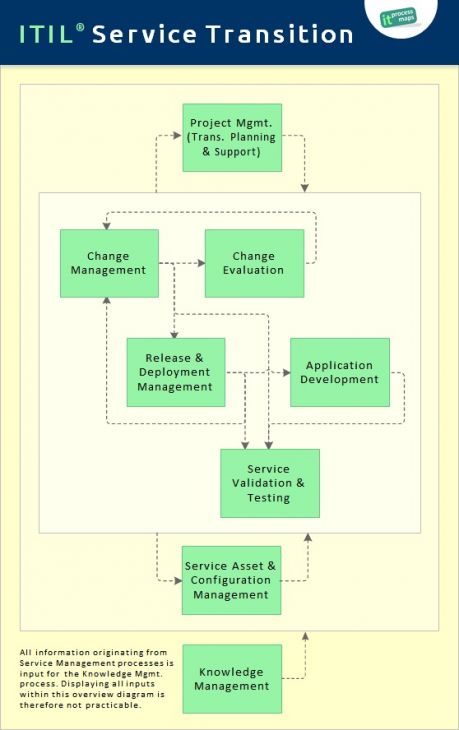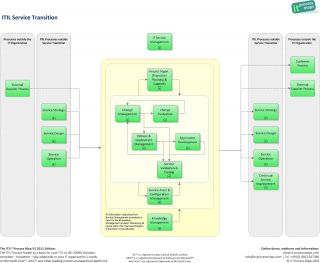ITIL Service Transition: Difference between revisions
No edit summary |
No edit summary |
||
| (One intermediate revision by the same user not shown) | |||
| Line 13: | Line 13: | ||
<meta property="og:image:width" content="558" /> | <meta property="og:image:width" content="558" /> | ||
<meta property="og:image:height" content="888" /> | <meta property="og:image:height" content="888" /> | ||
<link href="https://plus.google.com/108613479011811316823/posts" rel="publisher" /> | <link href="https://plus.google.com/108613479011811316823/posts" rel="publisher" /> | ||
</itpmch> | </itpmch> | ||
<imagemap> | <imagemap> | ||
Image:ITIL-Wiki-de-es.jpg|right|DE - ES - Service Transition|163px | |||
Image:ITIL-Wiki-de-es.jpg|DE - ES - Service Transition|163px | |||
rect 81 0 114 36 [https://wiki.de.it-processmaps.com/index.php/ITIL_Service_Transition_-_Serviceüberführung diese Seite auf Deutsch] | rect 81 0 114 36 [https://wiki.de.it-processmaps.com/index.php/ITIL_Service_Transition_-_Serviceüberführung diese Seite auf Deutsch] | ||
rect 115 0 163 36 [https://wiki.es.it-processmaps.com/index.php/ITIL_Transici%C3%B3n_del_Servicio esta página en español] | rect 115 0 163 36 [https://wiki.es.it-processmaps.com/index.php/ITIL_Transici%C3%B3n_del_Servicio esta página en español] | ||
| Line 107: | Line 94: | ||
<html>Since the processes specified in ITIL V3 have not been invalidated with the introduction of ITIL V4, organizations that need to define their Service Transition processes can still use the processes specified in ITIL V3 as templates.</p> | <html>Since the processes specified in ITIL V3 have not been invalidated with the introduction of ITIL V4, organizations that need to define their Service Transition processes can still use the processes specified in ITIL V3 as templates.</p> | ||
<p style=" | <p style="border: 8px solid #cef6e3; padding: 0.5em 1em;"><i><u>Note</u>:</i><br /> In our <i>YaSM Service Management Wiki</i> we describe a <a class="external" href="https://yasm.com/wiki/en/index.php/Service_Management_Processes" title="Service management processes">leaner set of 19 service management processes</a> that are more in tune with ITIL 4 and its focus on simplicity and "just enough process".<br /><br /> The YaSM service management model includes a <a class="external" href="https://yasm.com/wiki/en/index.php/LP3:_Build_new_or_changed_services" title="YaSM service implementation process">Service Transition / Service Implementation process</a> that is a good starting point for organizations that wish to adopt ITIL 4.</html> | ||
==<span id="Additional_Information_on_Service_Transition">KPIs | Templates | Roles</span>== | ==<span id="Additional_Information_on_Service_Transition">KPIs | Templates | Roles</span>== | ||
| Line 185: | Line 172: | ||
[[Category:ITIL V3]][[Category:ITIL 2011]][[Category:ITIL stage]][[Category:ITIL process|3]][[Category:Service Transition|!]] | [[Category:ITIL V3]][[Category:ITIL 2011]][[Category:ITIL stage]][[Category:ITIL process|3]][[Category:Service Transition|!]] | ||
<!-- --- --> | <!-- --- --> | ||
Latest revision as of 11:49, 31 December 2023

Objective: The objective of ITIL Service Transition is to build and deploy IT services. The Service Transition lifecycle stage also makes sure that changes to services and service management processes are carried out in a coordinated way.
Part of: IT Service Management | ITIL processes
Processes: ITIL Service Transition
Service Transition builds and deploys new or modified services.

The ITIL service lifecycle stage of Service Transition (see fig. 1) includes the following main processes:
- Change Management
- Process Objective: To control the lifecycle of all Changes. The primary objective of Change Management is to enable beneficial Changes to be made, with minimum disruption to IT services.
- Change Evaluation
- Process Objective: To assess major Changes, like the introduction of a new service or a substantial change to an existing service, before those Changes are allowed to proceed to the next phase in their lifecycle.
- Project Management (Transition Planning and Support)
- Process Objective: To plan and coordinate the resources to deploy a major Release within the predicted cost, time and quality estimates.
- Application Development
- Process Objective: To make available applications and systems which provide the required functionality for IT services. This process includes the development and maintenance of custom applications as well as the customization of products from software vendors.
- Release and Deployment Management
- Process Objective: To plan, schedule and control the movement of releases to test and live environments. The primary goal of Release Management is to ensure that the integrity of the live environment is protected and that the correct components are released.
- Service Validation and Testing
- Process Objective: To ensure that deployed Releases and the resulting services meet customer expectations, and to verify that IT operations is able to support the new service.
- Service Asset and Configuration Management
- Process Objective: To maintain information about Configuration Items required to deliver an IT service, including their relationships.
- Knowledge Management
- Process Objective: To gather, analyze, store and share knowledge and information within an organization. The primary purpose of Knowledge Management is to improve efficiency by reducing the need to rediscover knowledge.
ITIL 4 Service Transition
The Service Transition processes described here (fig. 1) follow the specifications of ITIL V3, where Service Transition is the third stage in the Service Lifecycle.
ITIL V4 has moved from the Service Lifecycle concept to a more holistic approach that includes key concepts, the Four Dimensions Model and the Service Value System (SVS).
Instead of processes, ITIL 4 describes 34 'practices', and many of the 26 processes specified in ITIL V3 can be found in ITIL 4 as practices. For example, ITIL V4 refers to Change Management and Configuration Management as practices (Change Management has been renamed to "Change Enablement").
The shift from processes to practices means ITIL V4 is no longer prescriptive about processes and gives organizations more freedom to define tailor-made Service Transition processes.
Since the processes specified in ITIL V3 have not been invalidated with the introduction of ITIL V4, organizations that need to define their Service Transition processes can still use the processes specified in ITIL V3 as templates.
Note:
In our YaSM Service Management Wiki we describe a leaner set of 19 service management processes that are more in tune with ITIL 4 and its focus on simplicity and "just enough process".
The YaSM service management model includes a Service Transition / Service Implementation process that is a good starting point for organizations that wish to adopt ITIL 4.
KPIs | Templates | Roles
- KPIs for Service Transition
- Service Transition templates and checklists
- ITIL roles within Service Transition
Downloads

Use the following links to open the process overview of Service Transition showing the most important interfaces:
Notes
By: Stefan Kempter ![]() , IT Process Maps.
, IT Process Maps.
ITIL 4 Service Transition › Change Management › [...] › Release Mgmt. › Service Validation › Configuration Mgmt. › Knowledge Mgmt.






